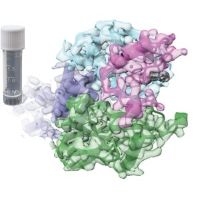Specification
| Organism | Homo sapiens (Human) |
| Expression Host | E.coli |
| Tag Info | N-terminal 6xHis-tagged |
| Purity | Greater than 85% by SDS-PAGE |
| Uniprot ID | Q96KS0 |
| Gene Names | EGLN2 |
| Alternative Names | Estrogen-induced tag 6HPH-3Hypoxia-inducible factor prolyl hydroxylase 1 ;HIF-PH1 ;HIF-prolyl hydroxylase 1 ;HPH-1;Prolyl hydroxylase domain-containing protein 1 ;PHD1 |
| Expression Region | Partial(283-407aa ) |
| Molecular Weight | 18.1 kDa |
| Protein Sequence | MVACYPGNGLGYVRHVDNPHGDGRCITCIYYLNQNWDVKVHGGLLQIFPEGRPVVANIEPLFDRLLIFWSDRRNPHEVKPAYATRYAITVWYFDAKERAAAKDKYQLASGQKGVQVPVSQPPTPT |
| Form | Liquid or Lyophilization |
| Buffer | The default storage buffer is Tris/PBS-based buffer, 5%-50% glycerol if the delivery form is liquid. The lyophilization buffer is Tris/PBS-based buffer, 6% Trehalose, pH 8.0 if the delivery form is lyophilized powder. Please contact us if you have any special requirment. |
| Reconstitution | Please reconstitute protein in deionized sterile water and we recommend that briefly centrifuge thevial prior to opening the vial .We recommend aliquot for long-term storage at -20℃/-80℃. |
Background
| Relevance | Cellular oxygen sensor that catalyzes, under normoxic conditions, the post-translational formation of 4-hydroxyproline in hypoxia-inducible factor (HIF) alpha proteins. Hydroxylates a specific proline found in each of the oxygen-dependent degradation (ODD) domains (N-terminal, NODD, and C-terminal, CODD) of HIF1A. Also hydroxylates HIF2A. Has a preference for the CODD site for both HIF1A and HIF2A. Hydroxylated HIFs are then targeted for proteasomal degradation via the von Hippel-Lindau ubiquitination complex. Under hypoxic conditions, the hydroxylation reaction is attenuated allowing HIFs to escape degradation resulting in their translocation to the nucleus, heterodimerization with HIF1B, and increased expression of hypoxy-inducible genes. EGLN2 is involved in regulating hypoxia tolerance and apoptosis in cardiac and skeletal muscle. Also regulates susceptibility to normoxic oxidative neuronal death. Links oxygen sensing to cell cycle and primary cilia formation by hydroxylating the critical centrosome component CEP192 which promotes its ubiquitination and subsequent proteasomal degradation. Hydroxylates IKBKB, mediating NF-kappaB activation in hypoxic conditions. Target proteins are preferencially recognized via a LXXLAP motif. |
| Involvement in Disease | |
| Subcellular Location | Nucleus |
| Protein Families | |
| Tissue Specificity | EGLN2 |
QC Data
| Note | Please contact us for QC Data |
| Product Image (Reference Only) |  |

